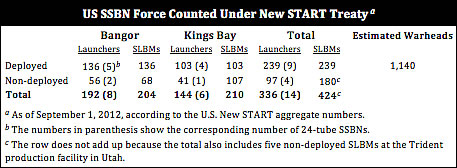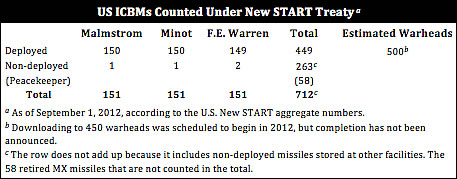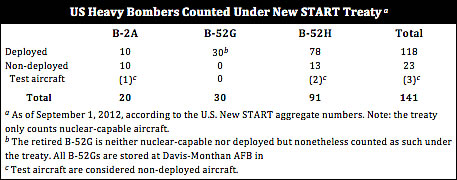New Detailed Data For US Nuclear Forces Counted Under New START Treaty
 |
| Air Force personnel perform New START Treaty inspection training on a Minuteman III ICBM payload section at Minot AFB in 2011. Nearly two years into the treaty, there have been few reductions of U.S. deployed strategic nuclear forces. |
.
By Hans M. Kristensen
The U.S. State Department today released the full (unclassified) and detailed aggregate data categories for U.S. strategic nuclear forces as counted under the New START treaty. This is the forth batch of data published since the treaty entered into force in February 2011.
Although the new data shows a reduction compared with previous releases, a closer reading of the documents indicates that changes are due to adjustments of delivery vehicles in overhaul at any given time and elimination on so-called phantom platforms, that is aircraft that carry equipment that make them accountable under the treaty even though they are no longer assigned a nuclear mission. Actual reduction of deployed nuclear delivery vehicles has yet to occur.
The joint U.S.-Russian aggregate data and the full U.S. categories of data are released at different times and not all information is made readily available on the Internet. Therefore, a full compilation of the September data is made available here.
Overall U.S. Posture
The data attributes 1,722 warheads to 806 deployed ICBMs, SLBMs, and heavy bombers as of September 1, 2012. This is a reduction of 15 deployed warheads and 6 deployed delivery vehicles compared with the previous data set from March 2012.
A large number of non-deployed missiles and launchers that could be deployed are not attributed warheads.
The data shows that the United States will have to eliminate 234 launchers over the next six years to be in compliance with the treaty limit of 800 deployed and non-deployed launchers by 2018. Fifty-six of these will come from reducing the number of launch tubes per SSBN from 24 to 20, roughly 80 from stripping B-52Gs and nearly half of the B-52Hs of their nuclear capability, and destroying about 100 old ICBM silos.

The released data does not contain a breakdown of how the 1,722 deployed warheads are distributed across the three legs of the Triad. But because the bomber number is disclosed and each bomber counts as one warhead, and because 450-500 warheads remain on the ICBMs (downloading to one warhead per ICBM was scheduled to resume in 2012), it appears that the deployed SLBMs carry 1,104 to 1,154 warheads, or more than two-thirds of the total number of warheads counted by New START.
Just to remind readers: the New START numbers do not represent the total number of nuclear weapons in the U.S. arsenal – only about a third. The total military stockpile is just under 5,000 warheads, with several thousand additional retired (but still intact) warheads awaiting dismantlement. For an overview, see this article.
Ballistic Missile Submarines
The New START data shows that the United States as of September 1, 2012, had 239 Trident II SLBMs onboard its SSBN fleet, a reduction of three compared with March 2012. That is only enough to fill nine SSBNs to capacity, but it doesn’t reflect an actual reduction of SLBMs or SSBNs but a fluctuation in the number of SLBMs onboard SSBNs during overhaul. Each SSBN has 24 missile tubes for a maximum loadout of 288 missiles (48 tubes on two SSBNs in overhaul are not counted), but at the time of the New START count it appears that two or three of the 14 SSBNs were empty (including the two in refueling overhaul) and two or three were only partially loaded (in missile loadout).

It is widely assumed that 12 out of 14 SSBNs normally are deployable, but the various sets of aggregate data all indicate that the force ready for deployment at any given time may be closer to 10. This ratio can fluctuate significantly and in average 64 percent (8-9) of the SSBNs are at sea with roughly 920 warheads. Up to five of those subs are on alert with 120 missiles carrying an estimated 540 warheads – enough to obliterate every major city on the face of the earth.
Of the eight SSBNs based at Bangor (Kitsap) Submarine Base in Washington, the data indicates that three were out of commission on September 1, 2012: one had empty missile tubes (possibly because it was in dry dock) and two others were only partially loaded. This means that five SSBNs from the base were fully loaded and probably deployed with 120 Trident II D5 missiles carrying some 540 warheads at the time of the New START count.
For the six SSBNs based at Kings Bay Submarine Base in Georgia, the New START data shows that 103 missiles were counted as deployed on September 1, 2012. That number is enough to load four SSBNs, with two other SSBNs only partially loaded. The four deployed SSBNs probably carried 96 Trident II SLBMs with some 430 warheads.
Intercontinental Ballistic Missiles
The New START data shows that the United States deployed 449 Minuteman III ICBMs as of September 1, 2012, the same number that was deployed in March 2012. Most were at the three launch bases, but a significant number (321) were at maintenance and storage facilities in Utah. That included 58 MX Peacekeeper ICBMs retired in 2003-2005 but which have not been destroyed.

The New START data does not show how many warheads were loaded on the 449 deployed ICBMs. Downloading to single warhead loading was scheduled to begin in FY2012, but a completion has not been announced. The warhead number is 450-500. The 2010 NPR decided to “de-MIRV” the ICBM force, an unfortunately choice of words because the force will retain the capability to re-MIRV if necessary.
Heavy Bombers
The New START data shows that the U.S. Air Force possessed 141 B-2 and B-52 nuclear-capable heavy bombers as of September 1, 2012. Of these, 118 were counted as deployed, a reduction of four compared with March 2012. The data shows that only half of the B-2 stealth bombers are deployed.

Unfortunately the bomber data is misleading because it counts 30 retired B-52G bombers stored at Davis-Monthan AFB in Arizona as “deployed” at Minot AFB in North Dakota. The mischaracterization is the result of a counting rule in the treaty, which says that bombers can only be deployed at certain bases. As a result, the 30 retired B-52Gs are listed in the treaty as deployed at Minot AFB – even though there are no B-52Gs at that base. According to Air Force Global Strike Command, “There are no B-52Gs at Minot AFB, N.D…In accordance with accounting requirements, we have them assigned to Minot and as visiting Davis-Monthan.” The actual number of deployed heavy bombers should more accurately be listed as 88 B-2A and B-52H, with another 53 non-deployed (including the 30 at Davis Monthan AFB.
All of these bombers carry equipment that makes them accountable under New START, but only a portion of them are actually involved in the nuclear mission. Of the 20 B-2s and 91 B-52Hs in the Air Force inventory, 18 and 76, respectively, are nuclear-capable, but only 60 of those (16 B-2s and 44 B-52Hs) are thought to be nuclear tasked at any given time. None of the aircraft are loaded with nuclear weapons under normal circumstances but are attributed a fake count under New START of only one nuclear weapon per aircraft even though each B-2 and B-52H can carry up to 16 and 20 nuclear weapons, respectively. Roughly 1,000 nuclear bombs and cruise missiles are in storage for use by these bombers. Stripping excess B-52Hs and the remaining B-52Gs of their nuclear equipment will be necessary to get down to 60 counted nuclear bombers by 2018.
Conclusions and Recommendations
The New START data released by the State Department continues the decision made last year to release the full U.S. unclassified aggregate numbers, an important policy that benefits international nuclear transparency and counters misunderstandings and rumors.
The latest data set shows that the U.S. reduction of deployed strategic nuclear forces over the past six months has been very modest: 6 delivery vehicles and 15 warheads. The reduction is so modest that it probably reflects fluctuations in the number of deployed weapon systems in overhaul at any given time. Indeed, while there have been some reductions of non-deployed and retired weapon systems, there is no indication from the new data that the United States has yet begun to reduce its deployed strategic nuclear forces under the New START treaty.
Those reductions will come slowly over the next five-six years to meet the treaty limits of 1,550 deployed strategic warheads and 800 deployed and non-deployed strategic delivery vehicles by February 2018. But almost two years after the New START treaty entered into force, it is clear that the Pentagon is not in a hurry to implement it.
This publication was made possible by a grant from the Ploughshares Fund. The statements made and views expressed are solely the responsibility of the author.
The FY2026 National Defense Authorization Act (NDAA) paints a picture of a Congress that is working to both protect and accelerate nuclear modernization programs while simultaneously lacking trust in the Pentagon and the Department of Energy to execute them.
While advanced Chinese language proficiency and cultural familiarity remain irreplaceable skills, they are neither necessary nor sufficient for successful open-source analysis on China’s nuclear forces.
Satellite imagery has long served as a tool for observing on-the-ground activity worldwide, and offers especially valuable insights into the operation, development, and physical features related to nuclear technology.
This report outlines a framework relying on “Cooperative Technical Means” for effective arms control verification based on remote sensing, avoiding on-site inspections but maintaining a level of transparency that allows for immediate detection of changes in nuclear posture or a significant build-up above agreed limits.